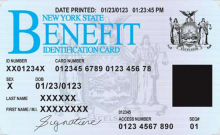New York Snap EBT Info Page
Welcome to SNAP EBT information page for the state of New York.
The New York SNAP program assists low-income New Yorkers, including working families, the elderly, and people with disabilities, in providing for their families’ nutritional needs.
An EBT card is given to eligible SNAP beneficiaries so they can use their cash benefits to make purchases at approved retail food outlets, including groceries and other items.
Picture of New York Snap EBT Card
Wondering what New York snap card looks like. Below is a sample picture.

This state EBT program is also known by these names:
Supplemental Nutrition Assistance Program (SNAP)
Common Benefit Identification Card (CBIC)
Contact Information
New York Snap Website
The website is http://otda.ny.gov/programs/snap/
New York Snap Phone Number
The phone number is +800-342-3009 (Upstate)
New York Local Office Location
Click Here to view office locations.
EBT Website
The website is https://www.connectebt.com/
New York EBT Phone Number
The phone number is +888-328-6399
Frequently Asked Questions
How can I Emergency Food Stamp in New York City?
Every SNAP application is examined for emergency eligibility on the day the application is submitted. Emergency SNAP benefits will be approved if you are eligible for “expedited benefits” within a few days but more than five days after applying.
What Can I Buy with Snap Benefits in New York?
You can purchase items such as
- Food or food products meant to be eaten by people
- Snack foods
- Seeds to grow vegetables and plants that provide food, such as basil or tomato
- Baby formula, diabetic, and diet foods
- Spices, herbs, pectin, shortening and other edible items used for cooking
- Water and ice labeled for human consumption
What items cannot be purchased with NY SNAP Benefits?
- Alcoholic beverages and tobacco
- Cleaning products, paper products, toiletries, and cooking utensils
- Pet supplies
- Items for food preservation, such as canning jars and lids, freezer containers, or food wrapping paper
- Medicines, vitamins, or minerals
- Prepared hot foods in grocery stores
